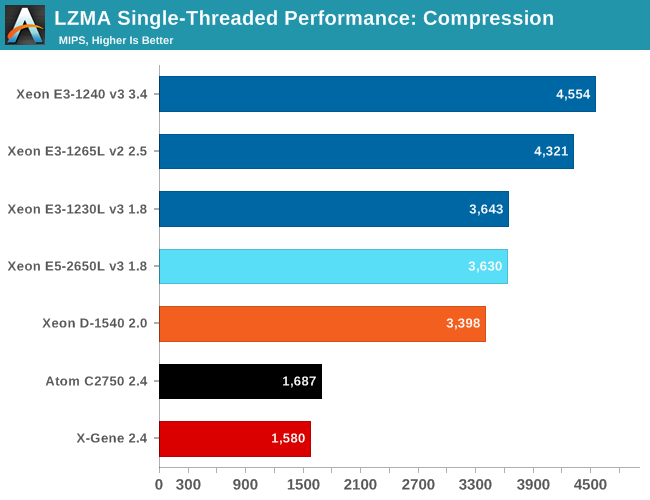The Intel Xeon D Review: Performance Per Watt Server SoC Champion?
by Johan De Gelas on June 23, 2015 8:35 AM EST- Posted in
- CPUs
- Intel
- Xeon-D
- Broadwell-DE
Single-Threaded Integer Performance
The LZMA compression benchmark only measures a part of the performance of some real-world server applications (file server, backup, etc.). The reason why we keep using this benchmark is that it allows us to isolate the "hard to extract instruction level parallelism (ILP)" and "sensitive to memory parallelism and latency" integer performance. That is the kind of integer performance you need in most server applications.
One more reason to test performance in this manner is that the 7-zip source code is available under the GNU LGPL license. That allows us to recompile the source code on every machine with the -O2 optimization with gcc 4.8.2.

The Xeon E5-2650L Haswell core is only able to boost to 2.5 GHz, while the Xeon D has a newer core (Broadwell) and is capable of 2.6 GHz. Still, the Xeon E5 is 6% faster. The most likely explanation is that the Xeon E5-2650L (65W TDP) keeps turboboost higher for a longer time than the Xeon D (45W TDP).
The Xeon D and Atom C2750 run at the same clockspeed in this single threaded task (2.6 GHz), but you can see how much difference a wide complex architecture makes. The Broadwell Core is able to run about twice as many instructions in parallel as the Silvermont core. The Haswell/Broadwell core results clearly show that well designed wide architectures remain quite capable, even in "low ILP" (Instruction Level Parallelism) code.
Let's see how the chips compare in decompression. Decompression is an even lower IPC (Instructions Per Clock) workload, as it is pretty branch intensive and depends on the latencies of the multiply and shift instructions.

The Xeon E5 runs at 2.5 GHz, the Xeon D at 2.6 GHz, the Xeon E3-1230L at 2.8 GHz, The Xeon E3-1265L can reach 3.7 GHz. The decompression results follow the same logic. There does not seem to be a difference between a Broadwell, Haswell or Ivy Bridge core: performance is almost linear with (turboboost) clockspeed. The only exception is the Xeon E3-1240 which turboboost to 3.8 GHz, but outperforms the other by a larger than expected. The explanation is pretty simple: the higher TDP (80 W) allows the chip to sustain turbo boost clock speeds for much longer.










90 Comments
View All Comments
zodiacfml - Tuesday, June 23, 2015 - link
this is the reason why Intel focuses on mobile, it benefits their server cpus too.the 14nm process is the one to thank for these massive improvements. Samsung also has 14nm and the S6 Exynos is in similar achievement
Refuge - Tuesday, June 23, 2015 - link
I disagree, the Exynos is no where close to a similar achievement.Granted it is doing better than Qualcomm's equivalent at the moment.
But I'm also faster than a fat man with a broken leg running on a hot and humid day.
zodiacfml - Tuesday, June 23, 2015 - link
Still, these 14nm SoCs are the best in their class as they pack more cores while using less power.LukaP - Thursday, June 25, 2015 - link
Just a note, Samsung's (and TSMC's 16nm FF(+) process isnt really 16nm entirely. The interconnects are still 28nm making it not nearly as dense as intel's 14nm, as well as being more leaky. IIRC their density and leakage can be compared to intels 22nm TriGate in the times of Ivy Bridgenils_ - Tuesday, June 23, 2015 - link
Few questions:1. Why did you disable x2apic?
2. Did the Large Page allocation in the Java Benchmark actually work? It can be a bit tricky some times and then falls back to 4KiB pages
3. What were the JVM settings for elasticsearch?
JohanAnandtech - Thursday, June 25, 2015 - link
1. Was out of the box disabled. I have to admit I did not check that option. Performance impact should be neglible though.2. I have no monitored that, but there was a performance impact if we disabled it.
3. ES_heap_size = 20 G; otherwise standard ES settings
Daniel Egger - Tuesday, June 23, 2015 - link
Wow, that is still quite pricey here. For the price of the SuperMicro tower you can actually get a 1U 2S Xeon E5 system with one socket equipped and some memory. I'd really love to replace my home server (running on Core i5 rather than Xeon E3 for efficiency reasons, those C chipset suck balls) with one of those systems if they can make them efficient and quiet.hifiaudio2 - Tuesday, June 23, 2015 - link
Two questions:1. How does the Xeon D compare to the c2700 series for a home NAS that will also serve as an Emby server and HDHR DVR (when that software is available). Could be one or two 1080p transcodes going on at the same time at most. Usually no transcoding if I am using Kodi or something that can natively play back the file, but for remote viewing or random uses over the network, some transcoding by Emby could be required -- if you are not familiar with Emby think of the same thing using Plex. So would the extra power of the Xeon D be of use to me, or is the 8 core c2750 plenty for the aforementioned use case?
2. If I do go with this unit, which dimms specifically does it use? The Supermicro c2750 board takes laptop style dimms. What does this take?
JohanAnandtech - Tuesday, June 23, 2015 - link
I can answer 2: see the picture here: http://www.anandtech.com/show/9185/intel-xeon-d-re... RDIMMs or UDIMMS (= basically "normal" DDR-4) will do.hifiaudio2 - Tuesday, June 23, 2015 - link
Thanks.. So this ram:?http://www.amazon.com/Crucial-PC4-2133-Registered-...
And what is the SR x4 / DR x8 difference in the two choices for the 8gb sticks?